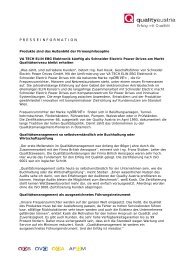Download of complete current Newsletter - IQNet Newsletter
Download of complete current Newsletter - IQNet Newsletter
Download of complete current Newsletter - IQNet Newsletter
Create successful ePaper yourself
Turn your PDF publications into a flip-book with our unique Google optimized e-Paper software.
<strong>Newsletter</strong> 09/2001 - n°2<br />
IBEC (<strong>IQNet</strong> Business Excellence<br />
Class)<br />
Business Excellence and ISO 9001:2000 - optimised integration<br />
and benefit<br />
ISO 9001:2000 and Excellence Models are management tools which<br />
complement each other perfectly. Success factors such as process management,<br />
resource management and customer focus, and in addition measurement,<br />
analysis and improvement, are focussed upon in ISO 9001:2000 more clearly<br />
than previously. They form the core <strong>of</strong> the implementation and formation <strong>of</strong><br />
quality management systems. In this way, the experience which has been gained<br />
through the growing use and application <strong>of</strong> Excellence Models around the world<br />
(in Europe the EFQM Model for Excellence) is also reflected in the new standard.<br />
The differences between the two management tools lie in their emphasis and<br />
their objectives. This is also reflected in the linguistic differentiation between<br />
“management system” and “quality management system”. However, the<br />
boundaries are flexible. Even ISO 9004:2000 addresses the topic <strong>of</strong> “selfassessment”<br />
and not only provides questions for this purpose, but also a table<br />
to define performance maturity levels. Thus QM systems which are based on the<br />
ISO series form an ideal basis for the further development <strong>of</strong> the organisation<br />
and the management system on the road to sustained superior performance.<br />
Excellence Models go further, in particular by placing emphasis on results,<br />
strategy and leadership and in the higher degree <strong>of</strong> attention they place on the<br />
numerous stakeholders <strong>of</strong> an organisation. People and their contribution are the<br />
crucial success factor in organizations - despite its central and decisive role in<br />
the organisation - is seen in the context <strong>of</strong> ISO 9001:2000 as no more than a<br />
human resource.<br />
By using the highly differentiated evaluation methods <strong>of</strong> the Excellence Models,<br />
makes it additionally possible to evaluate the management system as a whole<br />
and benchmark with others. It is also easier to measure achievements and the<br />
fulfilment <strong>of</strong> objectives, with emphasis on the critical success factors and/or<br />
stakeholders.<br />
The outward effects <strong>of</strong> an appropriately implemented QM system, as confirmed<br />
by a certificate, are particularly important in view <strong>of</strong> the world-wide coverage and<br />
acceptance <strong>of</strong> the ISO series. Thus the approaches <strong>of</strong> ISO 9001:2000 and the<br />
Excellence Models are not in conflict, but instead form a powerful team, i.e. they




